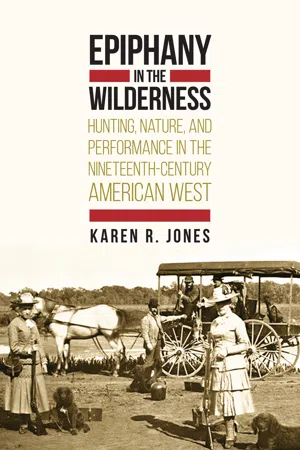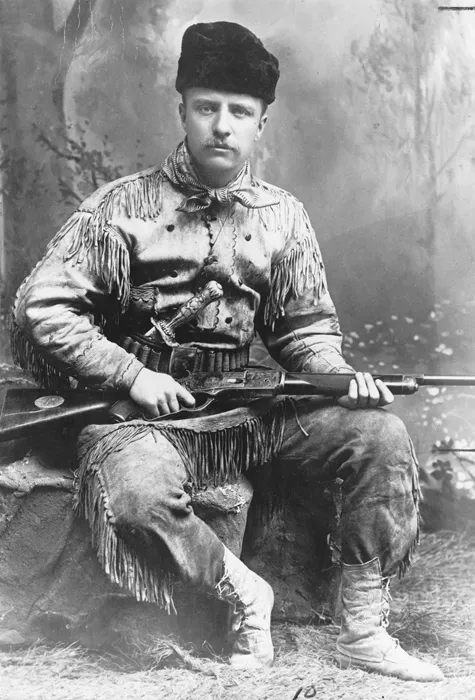Chapter 1
Masculinity, the “Strenuous Life,” and the Genealogy of the Hunter Hero
A cheerful fire, a full stomach, after an active and successful day a hunting, lying on a good cowboy bed, your peace pipe doing fine—a tried and true partner enjoying it all with you, your pulse beating with the warmth and strength of a hardy outdoor life; could a man wish for more?
—Malcolm Mackay, Cow Range and Hunting Trail (1925)
Born in New Jersey in 1881 and a stockbroker by trade, Malcolm Mackay had long been enticed by the literary frontier of cowboy and Indian heroes facing off across the pages of dime novels and popular fiction. Taking inspiration from the imaginary West, Mackay set out to find his own “inner frontiersman” in 1901. As he explained: “When I was nineteen years old, I was working in a banking house in New York, but somehow it in no way satisfied the hunger of real action and adventure that surged within me.” Settling in Red Lodge, Montana, Mackay struck up a partnership with rancher Charlie Wright and went on to operate a successful 17,000-acre spread on the East Rosebud River, running cattle under the Lazy EL brand. A keen outdoorsman—not least inspired by a duck hunt to Nebraska, aged sixteen, with a group of his father’s acquaintances—Mackay regularly left his ranch for the mountains in search of good hunting. The game trail brought muscular adventuring and invigoration for mind and body, so much so that Mackay spoke in quasi-mystical (not to mention Turnerian) terms of “spiritually turning from cowboy to hunter.” Wilderness living, the vigor of the rugged frontier, and the homo-social culture of the trail conspired to lend the hunting experience a unique quality and an innately performative timbre. As Mackay mused, “Could a man wish for more?”1
The masculine terrain of the Euro-American frontiersman set out in Mackay’s Cow Range and Hunting Trail was a familiar one. A material agent in the culture of animal capital, the hunter served as defender, provider, and adventurer—killing game to sustain his family—while recreational cultures of the hunt configured the pursuit of game as manly play, gallant sharpshooters trailing game across a theme park wilderness that was equally embedded in a political economy (and ecology) of western conquest. In the idealized terrain of frontier folklore, the hunter strode tall as a leading man, an individual who tamed the wild and transformed himself in the bargain. He was the principal actor in the cultural ecology of the hunt. One need only think of the famous photograph of Theodore Roosevelt (see Figure 1.1), posed in full buckskin regalia and grasping his Winchester, to see the critical purchase of the sporting hunter hero as a signifier of manliness, power, and authority (despite being taken in the less-than-wild setting of a New York studio). Contours of masculinity, conquest, and renewal shaped the hunting experience and, in turn, the environmental history of the West. As a cultural product too, the hunter hero exerted a powerful influence, indicated by such tomes as Heroes and Hunters of the West (1860) and its roll call of worthy frontiersmen figuratively led across the Cumberland Gap by Daniel Boone, “father of the West” and a man of “daring, activity and circumspection.” If encounters on the game trail said more about the two-legged than the four, then the principal protagonists were white men in particular.2
A number of scholars have traced the connections between masculinity, big game hunting, and colonialism. What has been less well observed, though, is the centrality of performance and theater to the cult of the hunter hero, the importance of the West to this typology, and the complex stratifications in the cultural ecology of hunting on the frontier. Whether expressed in trailside journals, tales around the campfire, or consciously paraded in a range of public forums from photography to staged shows, cultures of theater began on the game trail and extended far beyond the confines of the trans-Mississippi region. Drawing on autobiographical literature, this chapter reconstructs the phenomenology of the hunt as mediated by processes of masculinity in the American West to highlight the importance of the material space of the West (and its animals) as well as cultures of imaginative display. In the construction and dissemination of a heroic pedigree, the hunter hero participated in an encounter between physical space and an idealized “regeneration through violence” that was grounded in frontier geography, faunal exchange, and ritual performance. As Monica Rico notes, “The ritualized killing of wild animals incorporated a rich variety of gestures, objects, sayings, clothing, and images that, when woven together, told a story about masculine triumph over nature.” Axioms of self-discovery, proving and renewal, conquering “virgin” land, and competing with faunal “monarchs” graced the autobiographical canon and, critically, broadcast a repertory of ownership, domination, and power over western space. Meanwhile, facing up against the big game hunter, or sport hunter, were a range of alternative (sometimes heretical) models of masculine authority in the shape of the American Indian, the market hunter, and the frontier guide. With their own claims to heroic status, hunting prowess, and codes of regional belonging, these characters played key roles in the fantasy western architecture of masculine affirmation under construction in the “golden age” of sport hunting, often with intriguing results. The beatified hunter hero may have been resolutely western by the end of the 1800s, but his buckskin livery concealed a complex genealogy.3
The Crisis of Masculinity and the West as Hunter’s Paradise
The golden age of sport hunting in the West between the Civil War and the closure of the frontier in 1890 drew impetus from Anglo-American cultures of imperial power and racial legitimacy (as historians John Mackenzie, Daniel Herman, and Monica Rico have pointed out), along with the rise of an upper middle class keen to demonstrate their affluence and elite aspirations. Also critical was an intellectual climate on both sides of the Atlantic concerned with the deleterious effects of modernity and its so-called “crisis of masculinity.” As a reaction to many things—war, economic depression, and the confines of urban industrialism—the latter part of the century witnessed an outpouring of concern at the apparent overcivilization, feminization, and degeneration of the Euro-American man. Hunting Sports of the West (1865) bemoaned how “delicate canes and cushioned curricles have taken the place of rifles and the good old horseback exercises.” Solutions to the malaise were found in various quarters, from muscular Christianity to sport in the “great outdoors.” Frederick Jackson Turner felt that the Boy Scout movement offered the “foundation of a self-disciplined and virile generation worthy to follow the trail of the backwoodsman.” Hunting, in particular, stirred the attentions of many as an activity that challenged and channeled masculine instincts, promised healthy physical exertion and manly camaraderie, and stimulated vital emotions of duel and subdual. According to Elisha J. Lewis in The American Sportsman (1906):
Attention fixed on a number of sacred sites for the execution of cathartic hunting from the Adirondacks to Africa. Looming large in both national and transnational circles was the American West. John Mortimer Murphy in Sporting Adventures in the Far West (1870) referred to the Rockies and the Pacific slopes as “without a peer as a recreation-ground for those who love the ecstatic excitement of the chase,” a place of good outfitters, abundant game, and generally safe from “irritating insects, poisonous serpents or deadly disease.” With the construction of the transcontinental railroad and an incipient leisure economy tailored to those wishing for a dose of roughing it deluxe, the frontier was both accessible and usefully chaperoned. As Mortimer added, his hunting camp was always “within a few day’s march of civilization, and the high ways of communication with the outside world.”5
Long-standing associations of the West as wild terrain free not only from insects or snakes but also from modern strictures—an imaginative space where dreams gained full play—aided in its configuration as a locus of manly renewal. For British hunters seeking sport beyond the confines of (at least in relative terms) a domesticated landscape of deer and fox, and buoyed by an aristocratic colonial modus that saw far-flung reaches of the globe as useful exercise for younger sons suffering financial burden, primogeniture law, and rural change, the trans-Mississippi landscape represented an enticing space of primordial contest. Likewise, in the American national(ist) vernacular, the West had been consistently (and consciously) framed in opposition to the East in a series of turns that reflected both materiality and social construction: culture and nature, civilized and savage, constrained and liberated. Henry David Thoreau famously couched “the tonic of wildness” as an effective antidote to the quiet desperation of encroaching industrialism and encouraged a portentous gaze westward away from Old Europe and to the future, while the popula...

